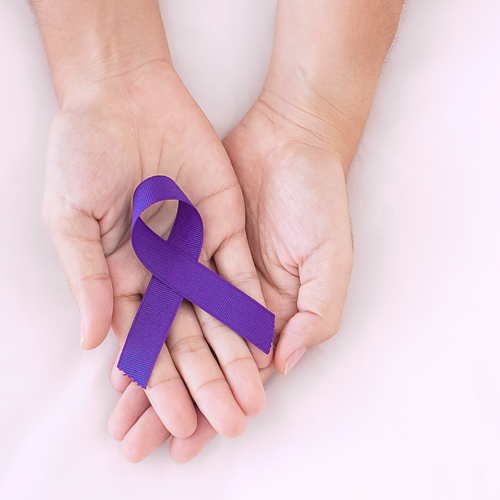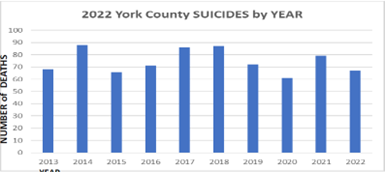News
September is Suicide Prevention Awareness Month
September is Suicide Prevention Month. Now more than ever, our country is witnessing an alarming number of mental health crises, suicide attempts and suicides. According to the CDC, in 2021:
- 3 million adults seriously thought about suicide
- 5 million adults made a plan
- 7 million adults attempted suicide
Suicide is a serious public health issue that can have long-lasting effects on individuals, families, and communities. Suicide is a leading cause of death in the United States and was responsible for more than 48,000 deaths in 2021. That equates to 1 death every 11 minutes.
According to the 2022 York County Coroner’s Annual Report, 67 individuals in York County committed suicide. For the past 10 years, that number has ranged between 60- 80 in the number of deaths in York County.

Many factors can increase the risk for suicide or protect against it. The loss of a loved one, isolation, financial stressors and health issues can be leading causes. Suicide is connected to other forms of injury and violence. For example, people who have experienced violence, including child abuse, bullying, or sexual violence have a higher suicide risk.
This includes individuals of all ages and races/ethnicities:
- Youth and young adults ages 10-24 now account for 15% of all suicides. Suicide rates have increased 52.2% between 2000-2021 for this age group, with suicide being the second leading cause of death.
- The racial/ethnic groups with the highest suicide rates in 2021 were non-Hispanic American Indian/Alaska Native and non-Hispanic White populations.
- In 2021, 26.3% of high school students identifying as lesbian, gay, or bisexual reported attempting suicide in the prior 12 months. This is five times higher than the rate reported among heterosexual students.

The good news is that suicide is preventable. Preventing suicide requires strategies at all levels of society. This includes prevention and protective strategies for individuals, families, and communities. Everyone can help prevent suicide by learning the warning signs, promoting prevention and resilience, and a committing to social change.
Many factors can increase the risk for suicide or protect against it. Suicide is connected to other forms of injury and violence. For example, people who have experienced violence, including child abuse, bullying, or sexual violence have a higher suicide risk.
This includes individuals of all ages and races/ethnicities:
- Youth and young adults ages 10-24 now account for 15% of all suicides. Suicide rates have increased 52.2% between 2000-2021 for this age group, with suicide being the second leading cause of death.
- The racial/ethnic groups with the highest suicide rates in 2021 were non-Hispanic American Indian/Alaska Native and non-Hispanic White populations.
- In 2021, 26.3% of high school students identifying as lesbian, gay, or bisexual reported attempting suicide in the prior 12 months. This is five times higher than the rate reported among heterosexual students.
The good news is that suicide is preventable. Preventing suicide requires strategies at all levels of society. This includes prevention and protective strategies for individuals, families, and communities. Everyone can help prevent suicide by learning the warning signs, promoting prevention and resilience, and a committing to social change.
- Check in on your family and friends. Stay connected through social media, a quick text or phone call, or lunch plans. You never know what someone may be going through.
- If someone needs to talk, listen. Let them know that you care and that they are not alone.
- You can help someone telling you they want to end their life by not leaving them on their own, seeking professional help, helping them create a crisis plan and removing potentially dangerous items around them.
- Become proactive by signing up for local trainings or workshops on how to help those who are struggling. Find local trainings in your area under “Local Activities/Trainings” below.
- Be knowledgeable about resources available and how someone can reach out for professional help. The 988 Suicide and Crisis Lifeline is free and available to call or text 24/7 if someone needs to talk or is experiencing a mental health-related crisis.
Need Help Now?
National Crisis Line
Contact the 988 Suicide and Crisis Lifeline if you are experiencing mental health-related distress or are worried about a loved one who may need crisis support. Call or text 988 to speak with a trained crisis counselor for free 24/7/365.
Local Supports
York/Adams Mental Health-Intellectual and Developmental Disabilities (MH-IDD) Program
TrueNorth Wellness Services Crisis Intervention- Call 1-866-325-0339 or (717) 637-7633
WellSpan Health Crisis Intervention- Call (800) 673-2496 or (717) 851-5320
Suicide Prevention Resources
Center for Disease Control and Prevention: https://www.cdc.gov/suicide/
Take 5 to Save Lives: https://www.take5tosavelives.org/learn
The Action Alliance: https://theactionalliance.org/
Suicide Prevention Training (free)
WellSpan Health Philhaven – Question, Persuade, and Refer (QPR) training is facilitated in person or virtually. Contact Jayne Miller, Community Mental Health Educator Coordinator at 717-273-8871, ext. 2248 or jmiller80@wellspan.org for more information.
